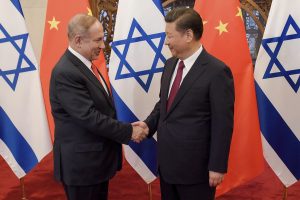By Mercy A. Kuo

Diplomat author Mercy Kuo regularly engages subject-matter experts, policy practitioners, and strategic thinkers across the globe for their diverse insights into Asia affairs. This conversation with Dr. Guy Burton – adjunct professor of international relations at Vesalius College in Brussels and author of “China and the Middle East Conflicts: Responding to War and Rivalry from the Cold War to the Present” (Taylor & Francis 2020) – discusses China’s strategic interests in the Middle East and its changing approach to the region.
Compare and contrast China’s past and present strategic interests in the Middle East.
There’s been a lot of attention on China as an economic actor in the region in recent years, especially in the wake of its Belt and Road Initiative. I wanted to tell China’s story from another angle, through war and rivalry from a historical perspective.
Viewed this way, it becomes clear that China’s regional involvement is neither recent nor as peaceful as it likes to portray itself. In the 1950s-60s, it identified closely with nationalist governments and movements in Algeria, Egypt, Palestine, Eritrea, and the Gulf and their struggles against colonial rule and imperialism, including financial and military assistance.
That approach changed in the 1970s when it began to prioritize diplomatic relations in the region. Arms sales were a useful way to do that, including sales to both sides in the Iran-Iraq war. From the 1990s, its relationships widened, to include interest in oil imports and wider trade and investment after 2000.
Explain how Beijing is expanding China’s geopolitical and geoeconomic influence in the region.
The Belt and Road Initiative overlays what has been a widening and deepening relationship between China and Chinese firms and the region. Before 2000, China was mainly concerned with access to oil and gas, which made relations with the Gulf increasingly important. But China’s interests have become much broader since then and include extensive trade and investment that goes both ways, with significant and sizeable investments in renewables, advanced technologies, finance, and services.
It helps that China has focused on building economic exchanges with countries in the region and avoided taking sides in the conflicts and rivalries there. Its willingness to work with everyone is highlighted by its ability to sign comprehensive strategic partnerships with both Saudi Arabia and Iran in 2016.
Identify the key factors driving conflicts between China and the Middle Eastern countries.
China’s previous support for insurgent movements in the 1960s undermined relations with regional governments. After opting for the diplomatic route from the 1970s, that tension dissipated. Since then, China has largely stayed out of the region’s conflicts. Instead, it has criticized foreign interference, especially by the West, including the 1991 and 2003 wars against Iraq as well as NATO’s intervention in Libya in 2011.
Regional governments have welcomed Chinese opposition to foreign interference. The Chinese approach is also useful given the volatile and uncertain nature of the Middle East. However, there are questions over how much longer this strategy can continue. China’s economic advance has been helped by “free riding” on others’ security provision, especially by the U.S. But as its investments grow, it may well find that it can’t rely on current arrangements. It may have to become more directly involved in protecting its interests. Should that happen, it may have to make some difficult choices, which may antagonize some of its current partners.
Assess the impact of the Abraham Accords on U.S-China rivalry in the Middle East.
China has good and growing relations with both Israel and the UAE. Chinese investment has been rising in both countries, especially in the hi-tech and digital sectors. Formalizing what was previously a clandestine relationship between Israel and the UAE can therefore only enhance the opportunities between the three.
What will determine how positive that impact will be is the U.S. Over the past year it has pushed Israel away from China on security grounds, whether over the development of the Haifa and Ashdod ports or in Israel’s 5G network. Israel has tried to balance its response by setting up a committee to assess foreign investment and avoid angering China too much.
So far, the U.S. hasn’t demanded the same of the UAE yet. Should it do so, then we may well see similar hedging by Abu Dhabi. As for China, the U.S. actions rile it, but it also doesn’t want to retaliate too strongly. Although important, it is further down the CCP’s hierarchy of priorities (after the homeland, Taiwan, Tibet, and East Asia).
Why should the U.S. and Europe be concerned about China’s role in the Middle East?
From a security perspective, I’d argue that U.S. fears are overblown. Since Obama, U.S. policy makers have feared that pulling out of the Middle East and pivoting to East Asia would leave the former space open to China. But there’s little sign that will happen. For one, China shows little willingness to become a major regional security provider. Its interventions over the Syrian war and in response to ISIS have been limited. It provided little practical assistance. For another, its current military presence is currently very modest. Only in 2017 did it open its first naval base in the region, in Djibouti.
At the same time, there is scope for the West to work with China where their interests overlap – although it does so on its own terms and in parallel with Western efforts. For example, China participated in anti-piracy operations off Somalia after 2009. It was also an important interlocutor between the West and the Sudanese and Iranian governments over Darfur and the 2015 nuclear deal respectively.
No comments:
Post a Comment